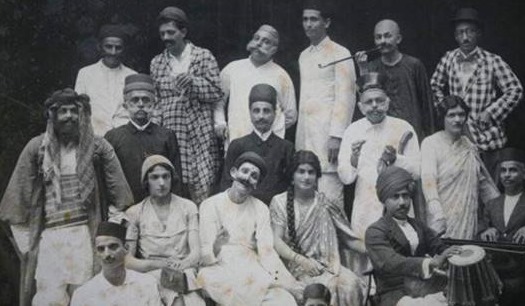For over a 100 years starting from 1850, a large number of proscenium theatres were built in the large cities, particularly Bombay and Calcutta.
A Parsi theatre troupe (File photo)
By FEISAL ALKAZI | Indian Express
For over a 100 years starting from 1850, a large number of proscenium theatres were built in the large cities, particularly Bombay and Calcutta. The plays performed here belonged to the ‘Parsi’ style. Myths and legends from history were played in an over-exaggerated style, with rhetorical, bombastic speeches, fainting heroines, rousing music and spectacular special effects.
The British tradition of the Victorian ‘melodrama’ usually mounted on a proscenium stage against a painted backdrop and wings had taken effective roots in Indian soil. This ‘Parsi Theatre’, as it came to be known in the country, created a vibrant tradition linking the local folk form with something more urban, more sophisticated. Many of these companies toured all over India. Some even travelled as far as Indonesia and East Africa.
Recently in Delhi, Black Pearl Arts presented a play in just this style—Munshi Dil Lakhnavi’s Laila Majnu directed by Zafar Sanjari. The play opens with husn (beauty) and ishq (love) debating whether one is possible without the other. All in rhyming Urdu couplets. They decide to show us the story of Laila Majnu, so we, the audience, can decide which precedes which: does beauty give rise to love, or is it the other way around?
Majnu enters chased by a crowd pelting stones at him and Laila soon follows, languishing in her home under the oppressive custody of her mother… and so it goes. A neat and tidy production with actors adept at both singing and acting, accompanied by a harmonium and tabla player. Yet one misses the grandeur of the large-scale ‘Parsi’ productions with constantly changing grand-painted settings, elaborate costumes and a full orchestra.
From the 1870s to the 1930s, it was the cosmopolitan population of Bombay, in particular the Khoja and Bohra communities, who became major patrons of this kind of theatre. And as time wore on, religious themes brought a new audience in search of ‘darshan’, and soon nationalist themes pulled in even more people, eager to watch ideas of political resistance disguised as history or myth.
Packed trains from Surat and Baroda would ply to Bombay. They were colloquially known as ‘so-and-so plays train’ carrying audiences hungry for theatre to Bombay. Fashions for women were set here: the latest hairstyle, the drape of a sari, the style of jewellery—similar to the contemporary Hindi film that dictates popular fashion.
At the peak of the popularity of the Parsi Theatre, money would be thrown on the stage in appreciation of a particularly poignant scene or the performance of a popular song. Not regular coins, for they could injure the actors, but silver coins in velvet pouches. So many were thrown at each performance that a special scrim curtain was lowered for the songs, so that the pouches wouldn’t spread across the entire stage.
The popularity of the songs often drew courtesans of the area keen to hear, hum, sing along and in this way learn the song that they would perform in turn for their patrons, while their musicians feverishly put down the musical notations during the encore. This was in an age before any recording devices. There could be up to 10 encores of each song, each one only made possible by additional money being thrown on the stage.
And then the movies came into being, snatching audiences away from live theatre forever.
The writer is a Delhi-based theatre director and can be reached at feisal.alkazi@rediffmail.com


